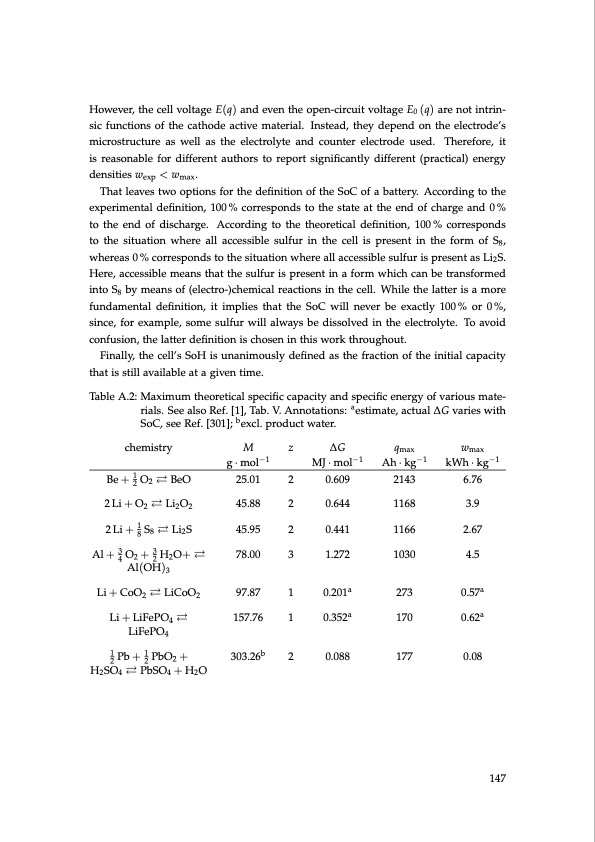
PDF Publication Title:
Text from PDF Page: 147
However, the cell voltage E(q) and even the open-circuit voltage E0 (q) are not intrin- sic functions of the cathode active material. Instead, they depend on the electrode’s microstructure as well as the electrolyte and counter electrode used. Therefore, it is reasonable for different authors to report significantly different (practical) energy densities wexp < wmax. That leaves two options for the definition of the SoC of a battery. According to the experimental definition, 100 % corresponds to the state at the end of charge and 0 % to the end of discharge. According to the theoretical definition, 100% corresponds to the situation where all accessible sulfur in the cell is present in the form of S8, whereas 0 % corresponds to the situation where all accessible sulfur is present as Li2S. Here, accessible means that the sulfur is present in a form which can be transformed into S8 by means of (electro-)chemical reactions in the cell. While the latter is a more fundamental definition, it implies that the SoC will never be exactly 100% or 0%, since, for example, some sulfur will always be dissolved in the electrolyte. To avoid confusion, the latter definition is chosen in this work throughout. Finally, the cell’s SoH is unanimously defined as the fraction of the initial capacity that is still available at a given time. Table A.2: Maximum theoretical specific capacity and specific energy of various mate- rials. See also Ref. [1], Tab. V. Annotations: aestimate, actual ∆G varies with SoC, see Ref. [301]; bexcl. product water. chemistry Be + 12 O2 BeO 2Li+O2 Li2O2 2 Li + 18 S8 Li2S Al+43O2+32H2O+ Al(OH)3 Li + CoO2 LiCoO2 Li + LiFePO4 LiFePO4 12 Pb + 12 PbO2 + H2SO4 PbSO4 + H2O M z g·mol−1 25.01 2 45.88 2 45.95 2 78.00 3 97.87 1 157.76 1 303.26b 2 ∆G qmax wmax MJ·mol−1 Ah·kg−1 kWh·kg−1 0.609 2143 6.76 0.644 1168 3.9 0.441 1166 2.67 1.272 1030 4.5 0.201a 273 0.57a 0.352a 170 0.62a 0.088 177 0.08 147PDF Image | Lithium-Sulfur Battery: Design, Characterization, and Physically-based Modeling

PDF Search Title:
Lithium-Sulfur Battery: Design, Characterization, and Physically-based ModelingOriginal File Name Searched:
Dissertation_David_N._Fronczek_The_Lithium_Sulfur_Battery.pdfDIY PDF Search: Google It | Yahoo | Bing
Sulfur Deposition on Carbon Nanofibers using Supercritical CO2 Sulfur Deposition on Carbon Nanofibers using Supercritical CO2. Gamma sulfur also known as mother of pearl sulfur and nacreous sulfur... More Info
CO2 Organic Rankine Cycle Experimenter Platform The supercritical CO2 phase change system is both a heat pump and organic rankine cycle which can be used for those purposes and as a supercritical extractor for advanced subcritical and supercritical extraction technology. Uses include producing nanoparticles, precious metal CO2 extraction, lithium battery recycling, and other applications... More Info
| CONTACT TEL: 608-238-6001 Email: greg@infinityturbine.com | RSS | AMP |